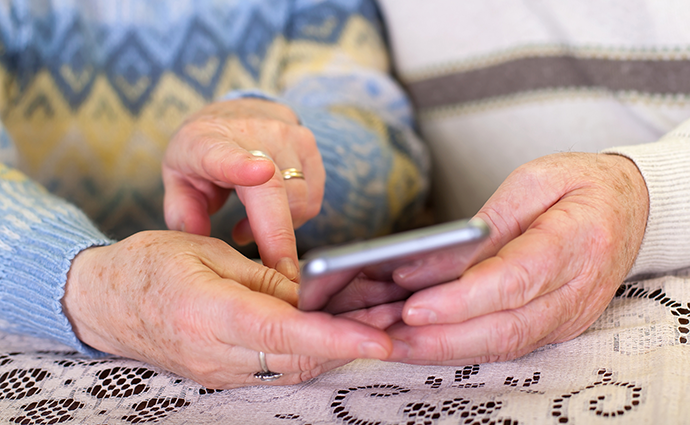Digital Onboarding Uses Telehealth to Start Conversations With Patients
Jefferson Health's Digital Onboarding Taskforce gives providers an opportunity to talk to patients and understand why they're reluctant or unable to access telehealth.

Source: ThinkStock
- When Jefferson Health received federal funding last year to purchase telehealth tools to help patients access care during the coronavirus pandemic, those in charge of the program realized they couldn’t just buy the iPads and connected health devices, hand them out and expect everyone to get the help they needed.
So the Philadelphia-based health system put together a task force designed to help patients learn how to use the new technology.
“You can’t just hand someone a device and expect they’re going to be on a telehealth visit the next day,” says Kristin Rising, MD, MS, associated professor and director of the Center for Connected Care. “Many people aren’t comfortable using telehealth. You have to find out why … and help them.”
Propelled in part by the rapid deployment of telehealth during the COVID-19 emergency, healthcare providers are scrambling to make sure those platforms are reaching the people they’re supposed to reach – and coming up against barriers to access that aren’t always tied to geography. They’re learning that barriers can be traced back to social or cultural issues, digital literacy, even insecurity or trust in the healthcare establishment.
“Many people don’t even see the need to engage in telehealth,” Rising adds.
READ MORE: Hollander: Don’t Measure Telehealth Value Against In-Person Healthcare
The Digital Onboarding Taskforce (DOT), launched last September by Rising and Rosie Frasso, PhD, a program director of public health in the Jefferson College of Public Health, aims to take a closer look at what’s keeping patients from using telehealth. Because much of the health system was dealing with surges brought on by the pandemic, Rising and Frasso populated the DOT with more than 30 students pursuing medical or public health degrees.
“Public health professionals have to be nimble and ready to fill in gaps, meet new challenges, educate communities, create connections and make things happen,” Frasso said in a story on the program published earlier this year in Nexus, the Thomas Jefferson University newsletter. “This is where our students came in. MPH students are required to do a clerkship where they apply what they’ve learned in the classroom to real-world health challenges. This project was just that.”
Starting with surveys and screenings, the task force identifies who would benefit from using telehealth and determines how much help they’d need adapting to the technology. It’s a step many health systems should take (and several have) – giving patients a quick refresher on how to use that app or device could go a long way toward improved and continued engagement and, in the long run, better outcomes.
“We start by looking at what’s going to be broken about this (telehealth interaction) from the patient’s point of view,” says Rising.
Just as important as the education is the conversation. While the students are helping patients get used to the technology – in some ways giving them confidence to manage their own health – they’re also chatting about other things.
READ MORE: New Coalition, Programs Focus on Establishing Telehealth Equity
“We end up having little side conversations here and there, talking about random things,” Amanda Guth, a Masters of Public Health student, told Nexus. “Many of these patients are older and live by themselves or maybe see a caregiver once a day. I think they appreciate the human connection, and so do we.”
Rising says those interactions help patients become more comfortable using the technology, a prelude to engaging with healthcare providers. This builds trust in both the tools and the health system. That’s important at a time when people – especially seniors and those living alone – are loathe to answer the phone or open their door to strangers.
“These students are repeatedly having very meaningful conversations with them,” she says. “This is how we can build relationships.”
These conversations can also lead to more interactions between patients and providers, offering them a better idea of the challenges patients face in accessing healthcare – often called social determinants of health. This, in turn, may allow providers to use connected health to address those challenges.
“Our healthcare system is due for some disruptive structural changes to improve the equitable access to high-quality care,” Geoffrey Hayden, MD, an emergency physician at Jefferson and Health Equity Scholar with the Cambridge Health Alliance who recently joined the DOT team to facilitate the students’ patient outreach efforts, said in the Nexus article. “Health technology definitely has the potential to level a playing field that has long been uneven and frankly unfair to some patients.”
READ MORE: Study Finds Underserved Communities Are Receptive to mHealth Tools
Rising, whose research over the past few years has focused on identifying factors that contribute to patient struggles in managing their health outside the healthcare setting, sees technology as a means to reducing those barriers. But technology alone won’t solve problems that begin with the simple need to connect.
“Telehealth has the potential to decrease our digital divide,” she says. “But we need to know how to use it first.”
